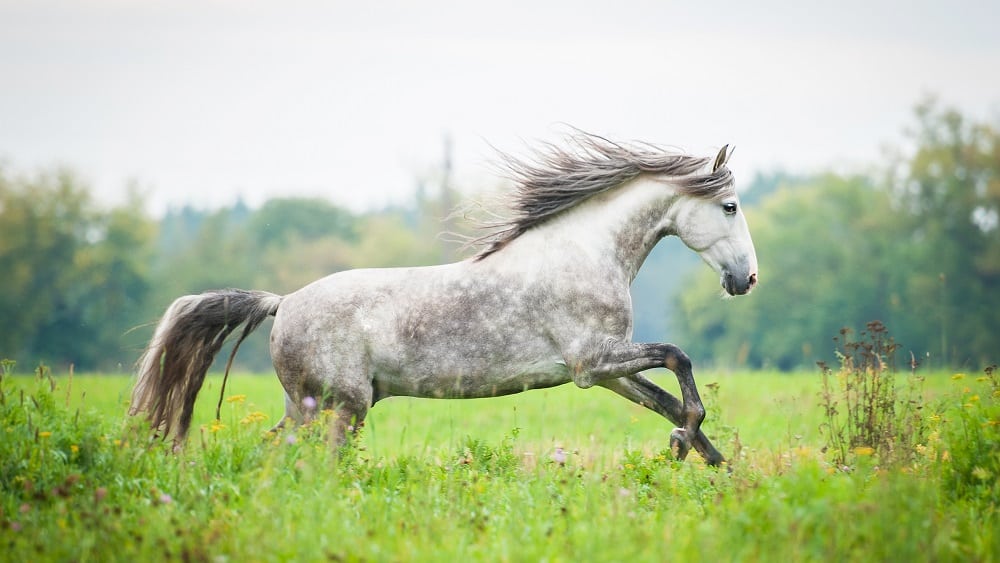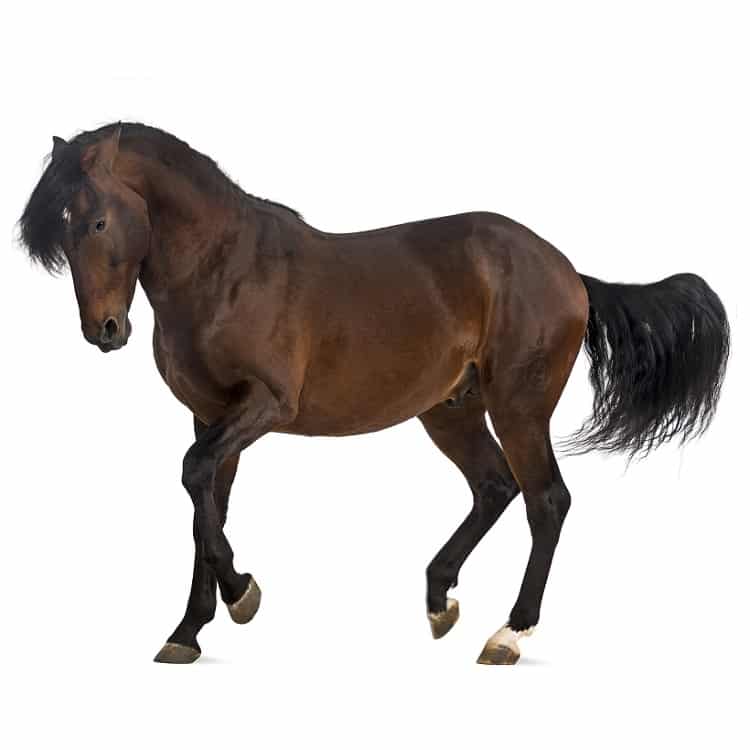
Vital Stats
| WEIGHT: | 410 – 510 kg |
| HEIGHT: | 15 ½ – 15.1 ½ hands |
| LIFE EXPECTANCY: | 25 years |
| BEST FOR: | dressage, leisure and trail riding, show jumping, events, and more |
| ORIGIN: | Andalusia, Spain |
Order within 52 mins for Next Day Delivery
Striking in both appearance and temperament, the elegant Andalusian horse hails from the Iberian peninsula of Spain and dates back to the 15th century, when it was first recognised as a distinct breed. Skilled as a war horse, nobility and royalty often chose the Andalusian as their mount; today, the breed is often seen in equestrian competition, driving, and on screen in both film and TV.
The modern Andalusian is not much changed from its ancestors, maintaining its original intelligence, strong build, and elegant appearance. Their long, thick manes and tails are one of the breed’s more recognisable characteristics, as is their agility and ability to learn.
It wasn’t until the 1960s that the export of Andalusian horses from Spain was allowed, and there are now over 185,000 Andalusian horses around the world.


| WEIGHT: | 410 – 510 kg |
| HEIGHT: | 15 ½ – 15.1 ½ hands |
| LIFE EXPECTANCY: | 25 years |
| BEST FOR: | dressage, leisure and trail riding, show jumping, events, and more |
| ORIGIN: | Andalusia, Spain |
Strikingly elegant, the Andalusian horse hails from the Iberian Peninsula in Spain and was first recognised as a distinct breed in the 15th century. Also known as the Pure Spanish Horse or PRE, the Andalusian is a close relative of the Portuguese Lusitano horse. The purest type of Andalusian horse is considered to be the Carthusian strain, which commands a premium as a result.
Andalusian horses were originally used as cavalry horses, and over the years they became popular with the nobility, gaining a reputation as the “Royal horse of Europe”. They were often gifted to prominent diplomatic figures by Spanish governments, and even King Henry VIII had a number of these Iberian horses in his royal stables.
The Andalusian horse has also had a significant influence on other horse breeds throughout its history, including the Friesian, the American Quarter Horse, and the Hanoverian.
Despite their popularity, Andalusian horses have faced the threat of extinction a number of times throughout their history as a result of theft during wartime; an epidemic; and the introduction of other bloodlines. However, the 21st century saw a recovery in numbers and today there are over 185,000 Andalusian horses worldwide.
Traditionally a war horse also used for activities such as driving and bullfighting, the modern day Andalusian is often seen in equestrian competitions such as dressage and show jumping; as a driving horse; in film and on tv; and for leisure riding.
Andalusian stallions and geldings weigh in at around 510kg and stand at about 15.1 ½ hands high; while mares weigh approximately 410kg and stand at about 15 ½ hands high.
In Spain, the Andalusian horse’s country of origin, the minimum height for registration is 15hh for stallions and 14.3hh for mares, as set by the Spanish government.
The Andalusian horse boasts a noble appearance, and is known for its elegant, strong build; and long, thick mane and tail.
Over the years, Andalusian horses have displayed most coat colours; today, gray and bay Andalusians are the most common, with black, dun, palomino and chestnut also seen. While rare, buckskin, pearl and cremello colours are also allowed by Andalusian breed registries.
The Andalusian horse is considered to be an ‘easy keeper’, which means a close eye needs to be kept on their diet to ensure your Iberian equine maintains a healthy weight and avoids potential issues such as laminitis. Andalusian horses tend to require a diet of quality hay; pasture access may need to be limited, and a grazing muzzle can be used to help prevent overeating.
Aside from their strikingly elegant appearance, the Andalusian horse displays a number of unique characteristics. Their extended, elevated movement makes them popular with competitive equestrians, as does their intelligence and ability to quickly learn difficult moves.
The Carthusian strain is also known to have warts under the tail, passed down from its founding stallion named Esclavo; and horns near the ears.
The Andalusian horse is generally docile, sensitive and smart: they are intelligent and quick to learn, making them easy to train in the right hands. They have an obedient nature, an ability to adapt, and a strong desire to learn.
However, the Andalusian horse can also be spirited: this, combined with their quick nature, makes them a better fit for more experienced horse riders and owners.
As an easy keeper, Andalusian horses can be prone to excessive weight gain, and a close eye needs to be kept on their daily diet. Andalusian horses are also susceptible to metabolic conditions.
Andalusian horses can also be at risk of a number of conditions, including ischaemic diseases of the small intestine; while Andalusian stallions can also be prone to inguinal hernias.
As a result of these intestinal issues, Andalusian horses may also suffer from laminitis: an inflammatory condition in horse hooves which requires fast diagnosis and treatment.
Their gloriously thick manes and tails are a defining characteristic of the Andlusian horse – and they require a little extra care when it comes to grooming to keep them looking in top condition. Regular trimming and pulling are a key part of the Andalusian horse’s grooming regime; their manes can also be braided to keep them free from knots, while their tails can be tied up to keep them away from the ground.
For the Andalusian horse’s coat, regular grooming will help to keep it looking healthy and glossy.
The typical lifespan of a healthy Andalusian horse is around 25 years.
The reasons to choose an Andalusian horse are plentiful. Their intelligence, obedience and desire to learn make them great for riders; while their docile temperament means they are a joy to train. Andalusian horses are usually better suited to a more experienced rider due to their quickness and forward movement.
The Andalusian horse is also a great option for dressage: as well as their intelligence and trainability, they display an elevated way of going, overtrack less than some other breeds, and move with upright steps.
This highly versatile horse is also used in show jumping and eventing, as well as leisure and trail riding.
Thanks to their striking appearance, Andalusians have also found work in the film industry, featuring in movies such as Gladiator, Braveheart, Lara Croft Tomb Raider, and The Lord of the Rings.
